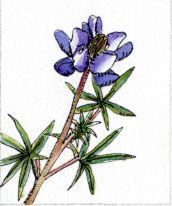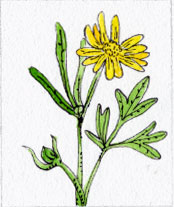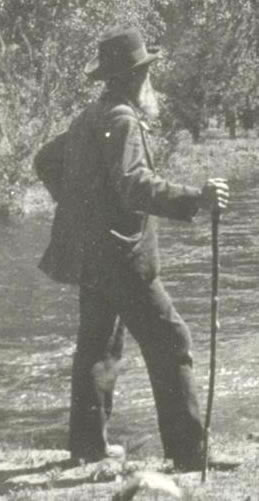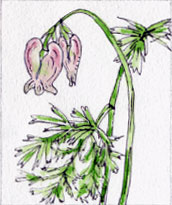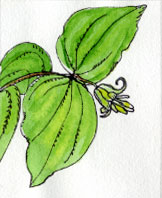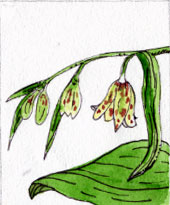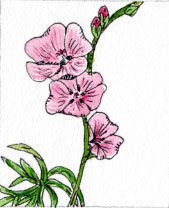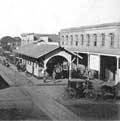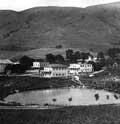I. New York to Oakland
A letter to brother David: Mar 3, 1868
(This text is held in copyright and can be seen at UOP)
A letter to brother David: July 14, 1868
(This text is held in copyright and can be seen at UOP)
A letter to the Merrills: July 19, 1868
(This text is held in copyright and can be seen at UOP)
A letter to Mrs. Carr: July 26, 1868
Near Snelling, Merced Co., California, July 26th, [1868.]
I have had the pleasure of but one letter since leaving home from you. That I received at Gainesville, Georgia. I have not received a letter from any source since leaving Florida, and of course I am very lonesome and hunger terribly for the communion of friends. I will remain here eight or nine months and hope to hear from all my friends.
Fate and flowers have carried me to California, and I have reveled and luxuriated amid its plants and mountains nearly four months. I am well again, I came to life in the cool winds and crystal waters of the mountains, and, were it not for a thought now and then of loneliness and isolation, the pleasure of my existence would be complete. I have forgotten whether I wrote you from Cuba or not. I spent four happy weeks there in January and February.
I saw only a very little of the grandeur of Panama, for my health was still in wreck, and I did not venture to wait the arrival of another steamer. I had but half a day to collect specimens. The Isthmus train rushed on with camel speed through the gorgeous Eden of vines and palms, and I could only gaze from the car platform and weep and pray that the Lord would some day give me strength to see it better.
After a delightful sail among the scenery of the sea I arrived in San Francisco in April and struck out at once into the country.
A letter to "twin Ann": Aug 15, '68:
(This text is held in copyright and can be seen at UOP)
Rambles of a Botanist: 1872
...On the second day of April, 1868, I left San Francisco for Yosemite Valley, companioned by a young Englishman. Our orthodox route of "nearest and quickest" was by steam to Stockton, thence by stage to Coulterville or Mariposa, and the remainder of the way over the mountains on horseback. But we had plenty of time, and proposed drifting leisurely mountainward, via the valley of San Jose, Pacheco Pass, and the plain of San Joaquin, and thence to Yosemite by any road that we chanced to find; enjoying the flowers and light, "camping out" in our blankets wherever overtaken by night, and paying very little compliance to roads or times. Accordingly, we crossed "the Bay" by the Oakland ferry...
Pelican Bay Manuscript: 1907
(This text is held in copyright and can be seen at UOP)
The Yosemite: 1911
When I set out on the long excursion that finally led to California I wandered afoot and alone, from Indiana to the Gulf of Mexico, with a plant-press on my back, holding a generally southward course, like the birds when they are going from summer to winter. From the west coast of Florida I crossed the gulf to Cuba, enjoyed the rich tropical flora there for a few months, intending to go thence to the north end of South America, make my way through the woods to the headwaters of the Amazon, and float down that grand river to the ocean. But I was unable to find a ship bound for South America--fortunately perhaps, for I had incredibly little money for so long a trip and had not yet fully recovered from a fever caught in the Florida swamps. Therefore I decided to visit California for a year or two to see its wonderful flora and the famous Yosemite Valley. All the world was before me and every day was a holiday, so it did not seem important to which one of the world's wildernesses I first should wander.
Arriving by the Panama steamer, I stopped one day in San Francisco and then inquired for the nearest way out of town. "But where do you want to go?" asked the man to whom I had applied for this important information. "To any place that is wild," I said. This reply startled him. He seemed to fear I might be crazy and therefore the sooner I was out of town the better, so he directed me to the Oakland ferry.
1000 mile walk: 1916
The day before the sailing of the Panama ship I bought a pocket map of California and allowed myself to be persuaded to buy a dozen large maps, mounted on rollers, with a map of the world on one side and the United States on the other. In vain I said I had no use for them. "But surely you want to make money in California, don't you? Everything out there is verydear. We'll sell you a dozen of these fine maps for two dollars each and you can easily sell them in California for ten dollars apiece." I foolishly allowed myself to be persuaded. The maps made a very large, awkward bundle, but fortunately it was the only baggage I had except my little plant press and a small bag. I laid them in my berth in the steerage, for they were too large to be stolen and concealed.
There was a savage contrast between life in the steerage and my fine home on the little ship fruiter. Never before had I seen such a barbarous mob, especially at meals. Arrived at Aspinwall-Colon, we had half a day to ramble about before starting across the Isthmus. Never shall I forget the glorious flora, especially for the first fifteen or twenty miles along the Chagres River. The riotous exuberance of great forest trees, glowing in purple, red, and yellow flowers, far surpassed anything I had ever seen, especially of flowering trees, either in Florida or Cuba. I gazed from the car-platform enchanted. I fairly cried for joy and hoped that sometime I should be able to return and enjoy and study this most glorious of forests to my heart's content. We reached San Francisco about the first of April, and I remained there only one day, before starting for Yosemite Valley.
Life and Letters of John Muir, William Frederic Bade: 1924
The North American Company at this time had ordered from New York a new steamship for its Pacific Coast traffic. This was the Nebraska, and she had sailed early m January, 1868, on her long maiden voyage around Cape Horn. Muir found that the Santiago de Cuba was scheduled to sail for Aspinwall on the 6th of March, and that her passengers would connect with the northward-bound Nebraska on the Pacific side of the Isthmus of Panama in about ten days. The records show that the Santiago de Cuba, not a large boat, carried on this trip four hundred passengers and five hundred and forty-two tons of freight. So overcrowded was the vessel that many passengers had to sleep on the decks. Nevertheless Muir engaged steerage passage on this boat and made connections with the Nebraska.
Son of the Wilderness, by Linnie Marsh Wolfe: 1946
About mid-February he was on an orange steamer en route for New York, clinging to a mast on deck while the storms that raged off Cape Hatteras beat upon him and cooled his blood. On March 10 he sailed for Aspinwall and the Isthmus on his way to "California's weeds and flowers." His steerage accommodations in a ship jammed to the gunwales with humanity did not afford him a pleasant voyage. Loathe always to dwell upon hardships, he could never be induced to talk about it. His journal dismisses it with the single comment: "Never had I seen such a barbarous mob, especially at meals."
On the morning of March 28, 1868 John Muir landed on the San Francisco wharf. With him was a globe-trotting cockney named Chilwell, who had agreed to go with him to the mountains. As they walked up Market Street, Muir saw nothing but the ugliness of commercialism. Stopping a carpenter with a kit of tools, he asked where he could find the quickest way out of the city, "But where do you want to go?" asked the man, "Anywhere that is wild," said Muir. "He seemed to fear that I might be crazy, and that .the sooner I got out of town the better, so he directed me to the Oakland ferry."
Exultant at being now "on the wild side of the continent," Muir with his companion was soon tramping southward from Oakland among the green, rounded, oak-clothed hills toward the Santa Clara Valley.
